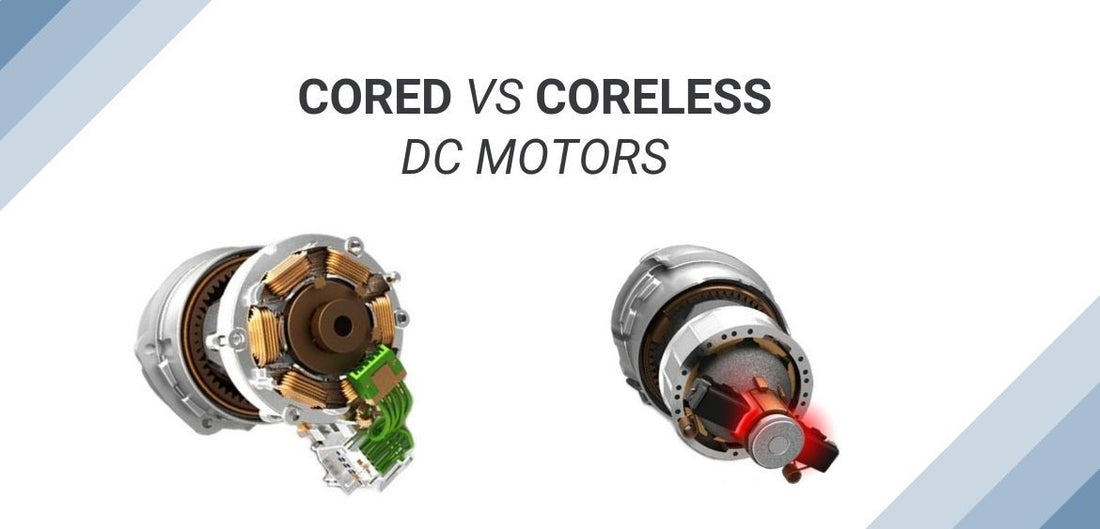A brushed DC electric motor converts electrical energy into mechanical energy using Lorentz Law, which states that “a current-carrying conductor placed in a magnetic field will experience a force”. This force can be used in a variety of ways, such as in a linear actuator to convert rotational motion into linear motion.
Progressive Automations offers a variety of linear actuators containing either a cored or coreless DC motor, but which type should you choose and why? We investigate the differences between a cored and coreless DC motor by looking at their construction and pros and cons. Moreover, we look at the operation, communication protocols, and feedback of different motors to allow you to make an informed decision.
Cored DC Motor
A cored, brushed DC motor is the most popular variety of motor due to its cost effectiveness to manufacture and produce in high volumes. A cored motor consists of a rotor (rotating), stator (stationary), commutator (commonly brushed), and permanent field magnets. Additionally, armature windings are wound around the iron core and connect to the commutator.

The brushes, contacting the commutator, are made from graphite/carbon, which allows a connected current to pass through and into the armature windings. The current through the windings produces a magnetic field that interacts with the stationary magnets and generates a force, which rotates the iron core, thereby, turning the motor shaft.
These motors are ideal for demanding applications due to their high starting torque and rigid iron core. They are less likely to overheat thanks to the iron core acting as a heat sink. Large-scale applications include electric cars, lifts, and pumps. Small-scale applications include locomotive sets, electric toothbrushes, and other toys.
Pros
- More cost-effective.
- High starting torque.
- Speed control over a wide range of voltages.
- Quick starting, stopping, and reversing.
- Free from harmonics.
Cons
- Lower electrical efficiencies (approximately 50%).
- High maintenance due to wearing brushes.
Coreless DC Motor
What is a coreless motor? It is similar to a cored DC motor in that it has brushes and a commutator. You also get brushless varieties. However, the difference is that the rotors windings are wound in a skewed (or honeycomb) fashion to form a self-supporting hollow cylinder, which is usually epoxied for stability.

The stator, which sits inside the hollow cylinder, is made of a rare earth magnet, such as Neodymium, AlNiCo (aluminium-nickel-cobalt), or SmCo (samarium-cobalt). The brushes in a coreless motor can be made from precious metal (e.g. silver, gold, or platinum) or graphite. The wire cylinder distributes the magnetic field throughout the structure when an electrical current is applied to the leads connected to the brushes and commutator, which interacts with the rare earth magnet to produce a force and rotate the shaft.
Coreless motors open up a wide variety of possibilities for use in robotics. A few applications include their extensive use in prosthetics, insulin pumps, laboratory equipment, and X-ray machines – all requiring high accuracy positioning.
Pros
- Small, lightweight, and compact design.
- Low noise and vibration operation.
- Highly efficient (approximately 90%).
- Longer life due to less electro-erosion.
- High acceleration and deceleration rates.
- Linear speed/torque characteristics allowing for easier control.
Cons
- Significantly more expensive.
- Cannot handle thermal overloads as there is no iron core to act as a heat sink for the rotor windings.
- Requires additional electronics (e.g. decoders).
Communication Protocols
If you are opting for a cored or coreless DC motor, you must consider the communication protocols for each one. The primary communication protocols include RS-485 and TTL/PWM communication. Which one you select will also determine the type of motor you can use.
RS-485 Communication
RS-485 communication is a popular serial communication protocol, which provides high-speed data transfer between devices. It is a robust, trusted standard of communication, able to provide reliable data over extended distances.
Progressive Automations offers the PA-12 high-precision linear actuator, which can be controlled using an Arduino microcontroller. However, there are two varieties offered, one using a cored DC motor (PA-12-T) and another using a coreless DC motor (PA-12-R).

If opting for the coreless variety, then RS-485 communication must be used. This protocol is easily implemented by using a TTL to RS-485 module to communicate with the Arduino. Alternatively, another microcontroller can be used, which communicates via RS-485 straight out the box.
TTL/PWM Communication
The PA-12-T linear actuator can be controlled directly with an Arduino microcontroller via TTL/PWM communication, reducing the cost of additional communication conversion modules. The linear actuator has precise position control with an accuracy of up to 100um.
Considering the previously discussed pros and cons of cored and coreless DC motors, the best solution will depend on the application. Both PA-12 linear actuators provide accurate position control, but the communication protocols are different.
Feedback
A key factor to determine what DC motor to opt for is deciding whether to attach some form of feedback. Feedback refers to any information that a controller can use to monitor a process and make corrections. For example, in the case of a DC motor, potentiometers, hall effect sensors, and encoders are common types of feedback.
A potentiometer converts a DC motor into a servo motor, allowing for precise position and speed control. The type of feedback can be applied to a cored or coreless DC motor, but it is essential to consider the various feedback options to make the best decision to suit the application. If you require high efficiency, high accuracy, opt for a coreless DC motor with an encoder as a reliable feedback option. However, this option is quite expensive and will depend on your budgetary constraints.
Conclusion
We have highlighted the pros and cons of cored and coreless DC motors, as well as the communication protocols and feedback options. Progressive Automations offer a variety of linear actuators containing a mix of these actuators/devices/sensors.
The decision depends on many factors, such as the specifications of the linear actuator the DC motor is attached to, the price, and the level of accuracy required. The application will determine the motor that is needed, and the motor will determine the specifications of the linear actuator. For more information on Progressive Automations products or for additional support, contact us today.




